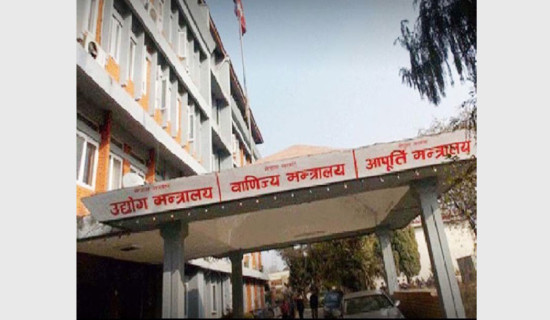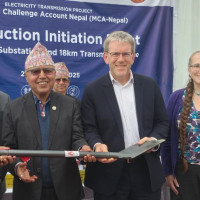- Wednesday, 26 November 2025
Nepal’s EV Journey For Cost And Clean Air Mileage
The NADA Auto Show, a premier event for automotive enthusiasts and industry professionals, concluded recently, signalling the city’s evolution in the automotive landscape.
The show remained particularly notable for its showcasing highlights on electric vehicles (EVs). It drew thousands of visitors, from industry insiders to eager consumers, all keen to witness the latest advancements in vehicle design and performance.
The spotlight, however, was firmly on electric vehicles. With global trends leaning towards greener alternatives, the Auto Show highlighted a display of new EV models.
Dozens of companies showcased their vehicles, and more than 90 per cent of them were EVs. The show showcased several prominent international and local EV brands, each showcasing their unique offerings. From sleek Sedans to rugged SUVs, a variety of electric vehicles on display illustrated the versatility and appeal of the rapidly evolving auto market.
Besides several new EV models from renowned global manufacturers, locally produced electric vehicles were also showcased. This dual focus highlighted Nepal's growing role in the global EV market as well as the increasing availability of eco-friendly options for local consumers.
Consumers' enthusiasm
The response from visitors was overwhelmingly positive and enthusiastic, said outgoing president of the NADA Automobiles Association of Nepal, Dr. Dhurba Bahadur Thapa.
More than 80,000 visitors observed the six-day exhibition. During the festival, around 4,000 vehicles were booked. Of them, notably, around 80 per cent vehicles were EVs. Attendees were particularly excited about the opportunity to test drive the latest EV models and explore their features up close.
Many visitors expressed their enthusiasm about the prospect of adopting electric vehicles, driven by the promise of reduced emissions and lower operating costs.
The show also featured informative seminars and workshops on the benefits of electric vehicles, including discussions on the latest advancements in battery technology, government incentives for EV buyers, and the infrastructure developments needed to support widespread adoption.
According to Thapa, the event not only catered to the growing demand for sustainable transportation but also highlighted the potential for Nepal becoming a key player in the global EV market.
With the growing interest of people towards EV in the past two years, the number of these vehicles has also increased on the road. This trend can be attributed to the government's customs subsidies for electric vehicles, coupled with the rising cost of petroleum products.
The cost of the electric-powered vehicles is nominal compared to the diesel-powered vehicles, which has attracted customers to purchase EVs. Moreover, the improvement in the supply of electricity in the country and concessions on charging tariffs for EVs provided by Nepal Electricity Authority have also encouraged many to buy electric vehicles.
In response to this shift, the government has begun implementing policies aimed at promoting electric vehicles. The global shift towards sustainable transportation is evident, and Nepal, renowned for its stunning landscapes, ecological consciousness, and abundant renewable energy resources, should lead the EV revolution.
Depending on the brand of the companies, EVs are available in the Nepali market, ranging in cost from Rs. 2 million to Rs. 15 million. But vehicles priced between Rs. 3.5 million and Rs. 6 million are preferred by customers
Growing market
Because of the low operating and maintenance costs and environment-friendly benefits, EVs have become popular in Nepal for the past few years. Over the past three years, the Nepali EV market has witnessed remarkable growth.
Dr. Thapa said that sales of EVs have been increasing significantly compared to petrol and diesel-powered vehicles in the last two years. Around 15,000 four wheelers used to be sold annually in the country. The share of EVs in total vehicle sales has now reached 75 per cent.
Over time, the range of electric vehicles available in Nepal expanded beyond two-wheelers to include electric cars, vans, and even electric buses. Domestic companies and international manufacturers have begun introducing a variety of electric vehicles to cater to different segments of the market.
According to the statistics of the Department of Customs, around 11,700 electric vehicles (cars, Jeeps, and vans) worth Rs. 29.48 billion were imported in the fiscal year 2023/24.
Around 4,050 four-wheeler electric vehicles were imported in the fiscal year 2022/23 and around 1,800 in the fiscal year 2021/22. The country imported only 249 units of electric vehicles in the fiscal year 2020/21. The EV import figure in the last fiscal year is three times more than those imported in FY 2022/23.
Use of light electric vehicles for public transportation has also increased in the country. Around 600 electric public vehicles, including vans, are operating along the BP Highway in Sindhuli. However, only a few big electric public buses for public transportation are in operation now.
Sajha Yatayat is operating around 50 electric public vehicles, and Sundar Yatayat is operating about 10 public buses.
In fact, EV is not new for Nepal. Earlier, trolley buses were commercially in use with the Chinese assistance from 1975 to 1990. But these first electric buses could not survive the mismanagement, corruption, and wrong priorities.
Economic and environmental plus points
The maintenance cost of electric vehicles is very low as compared to petrol and diesel-fuelled vehicles, and only tires, batteries, servicing, and cleaning costs are incurred, so the 'maintenance cost' of electric vehicles is less compared to other vehicles.
Experts say that electric vehicles are 10-15 times cheaper than those running on petroleum products. As electric vehicles do not emit carbon monoxide, which adversely affects the environment and human health like petrol and diesel vehicles, electric vehicles are environmentally friendly.
Nepal relies heavily on imported petroleum products for its transportation sector. By transitioning to electric vehicles, the country can reduce fuel imports and enhance its energy security. The country has been spending around Rs. 300 billion for the import of petroleum products annually. By promoting the use of EVs, a huge amount of money now being spent to import fuel could be saved, thereby reducing the widening trade deficit.
If the private and public vehicles running on petroleum products can be replaced with electric vehicles, a large amount of foreign currency will be saved in the future, and it will also help reduce the trade deficit.
Electricity prices are generally more stable and predictable than fossil fuel prices, resulting in potential long-term cost savings for EV owners. EVs offer cost savings in operation and maintenance compared to their fossil-fuelled counterparts. Their lower fuel and maintenance costs contribute to a significant reduction in overall transportation expenses. EVs look particularly beneficial for low-income households and small businesses.
Harish Nepal, who has started operating electric cars, said that compared to petrol/diesel vehicles, electric vehicles are better in terms of operation and maintenance costs and environment.
The operating expenses of electric vehicles are three times less compared to petrol and diesel-fuelled vehicles. But there is a challenge in its use due to a lack of sufficient charging stations.
"Driving an electric car for about 200 kilometres costs only Rs. 200 while driving a petrol-fuelled car; it is over Rs. 2,000,” he said.
Though the demand for electric cars is growing, entrepreneurs are still not encouraged towards the operation of electric public vehicles, Thapa said. "The government charges only one per cent tax for the import of above-14-seater electric public buses, but the high purchase cost of big electric public buses discourages entrepreneurs," he said.
"Buying a big electric passenger bus costs around Rs. 15 million to Rs. 20 million. Therefore, even though there are many benefits in operating big electric buses, businessmen are not able to operate such buses because of their high costs," he said.
Govt priorities
Nepal, like many other countries, has recognised the importance of transitioning to cleaner and more sustainable modes of transportation to address environmental concerns and reduce dependency on fossil fuels.
In the early 2000s and through the following decade, the concept of electric vehicles started gaining attention globally due to concerns over pollution and climate change. Nepal, being environmentally conscious and seeking alternative solutions to its energy needs, began exploring the potential of EVs.
The Nepal government took steps to promote the adoption of electric vehicles by introducing policies and incentives to encourage their use. These initiatives included tax breaks, subsidies, and import duty reductions on electric vehicles and related components. Nepal has set a goal to achieve net zero carbon emissions by 2045, which aligns with the growing global focus on climate change mitigation.
Dr. Thapa said that the customs subsidy given by the government on EVs has attracted customers to use such vehicles. He added that Nepal is only the country in the world that offers a heavier customs exemption on EVs than other fossil-fuelled vehicles. However, the government has increased the customs for EV in the current fiscal year budget.
Currently, the government is imposing only 15 per cent customs duty and 5 per cent excise duty on the import of electric vehicles of up to 50 KW capacity.
According to the new arrangement of the budget, the customs duty on electric vehicles between 50 and 100 kilowatts has been increased by 5 percentage points to 20 per cent and excise duty by 5 percentage points to 15 per cent.
Similarly, the government has imposed 30 per cent customs duty and 20 per cent excise duty on EV on 200 KW capacity. The customs duty on electric vehicles on 300 KW has increased to 60 per cent and excise duty has dropped to 35 per cent. For EV capacity above 300 KW, the customs duty has been increased to 80 per cent while excise duty has been reduced to 50 per cent.
Even increased customs duty in the current fiscal year, the customs duty has been significantly lower than the customs imposed on diesel/petrol-powered vehicles. The government imposes customs ranging from 200-300 per cent on diesel/petrol-powered vehicles.
The government has planned to replace petrol-powered vehicles with electric vehicles by 2050. All European countries, along with the United States, Canada, Australia, Japan, China, and India, have implemented concessions to promote the adoption of EVs.
Besides, banks are providing hire purchase loans up to 80 per cent of the value of electric vehicles, which is also encouraging people towards EVs.
Challenges and prospects
Despite government support, the adoption of EVs in Nepal is full of challenges, including the lack of adequate charging infrastructure, high initial costs of electric vehicles compared to conventional vehicles, and limited consumer awareness about the benefits of EVs.
Looking ahead, the future of electric vehicles in Nepal appears promising, with continued government support, advancements in technology, and growing environmental consciousness among the consumers.
However, challenges such as the need for more robust charging infrastructure, addressing range anxiety, and reducing the upfront costs of EVs remain key areas of focus for further encouragement and adoption.
The NEA has constructed and brought into operation 62 charging stations, while more than 400 charging stations built by the private sector are now in operation at different locations.
The transport sector is a huge energy consumer. As the government has planned to generate 28,500 MW of electricity by 2035, the domestic power consumption can be increased if the EVs are promoted.
With ongoing efforts and continued collaboration between the government, private sector, and civil society, Nepal is poised to accelerate the adoption of electric vehicles and contribute to a cleaner and greener future.
In conclusion, while the history of electric vehicles in Nepal is relatively short compared to some other countries, the nation has made significant strides in promoting them in a short time.
(Kafle is a journalist at The Rising Nepal.)

















